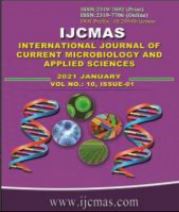


 National Academy of Agricultural Sciences (NAAS)
National Academy of Agricultural Sciences (NAAS)

|
PRINT ISSN : 2319-7692
Online ISSN : 2319-7706 Issues : 12 per year Publisher : Excellent Publishers Email : editorijcmas@gmail.com / submit@ijcmas.com Editor-in-chief: Dr.M.Prakash Index Copernicus ICV 2018: 95.39 NAAS RATING 2020: 5.38 |
Cauliflower (Brassica oleracea L. var. botrytis) is an excellent source of nutrient and containing low calorie, low fat and zero cholesterol content. Prolonged cooking of cauliflower destroys majority of vitamins and it is associated with bad smell. Perishable nature of cauliflower forces the farmers to sell it at a very low price during the glut season. In this situation, pickle is one of the oldest and most successful methods for preservation of cauliflower. The cauliflower pickles were prepared by using three types cauliflowers i.e. fresh (raw), boiled, fried and three (B1, B2 and B3) different proportions of spices with two replications. The prepared cauliflower pickles were packaged in air tight glass bottle. The different physico-chemical properties of cauliflower pickle such as moisture content, protein, vitamin C, ash content, pH and TSS were studied. The maximum values of moisture content 58.50 % (T5), protein contents 5.86 g/100g (T8), Vitamin C content 97.60 mg/100g (T6), ash content 3.92 % (T9) respectively and minimum values of moisture content 40.56 % (T7), protein contents 4.97 g/100g (T1), Vitamin C content 91.37 mg/100g (T9), ash content 0.91 % (T1) respectively. Increasing trend of pH and TSS values were observed with increasing storage period. The significant variations were observed for appearance, aroma, texture, taste, colour and overall acceptability. It also shows the sensory values for all properties were more than 5.00 up to 2 months storage periods. On the basis of storage studied of 0 months, 1 month, 2 months and 3 months on colour change, off flavour properties, texture and visual fungal growth of cauliflower pickles, the treatments T8, T9, T6 and T5 were observed better quality.
 |
 |
 |
 |
 |